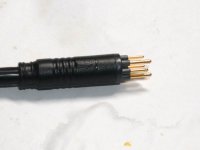wolfalohalani
1 µW
- Joined
- May 26, 2019
- Messages
- 3
My sister bought a conversion kit for her tricycle from Bikeberry, which you could see here: https://www.bikeberry.com/electric-bike-kits/750-watt-e-bike-kits/36v-750w-24in-front-fat-tire-electric-bicycle-electric-bike-motor-kit.html It was a family effort putting the conversion kit in, and we had a couple of days of triumph. Hurray, we can go get groceries on the ebike!
Riding on the level, I noticed the cable from the controller to the motor had fallen out. No problem, I put it back in, matching the arrows on the connectors. I coasted a block back to the house - when I got there, the motor no longer runs. When you apply throttle, the wheel twitches, but that's it. The wheel turns freely by hand with no noise.
So, on to debugging - what's busted? Problem is, BikeBerry has no idea what's in the kit they sold me, so it's hard to test what might be wrong. When I look at the connector from the controller to the motor, one of the pins has carbon on it. I'm assuming that this pin shorted as the connector came loose. Looking online, there's a pinout for the Higo Z910 connector on this page: https://www.ebikes.ca/news/controller-motor-higo/ Assuming that this diagram is correct, and the top of the diagram corresponds to the arrow on the outside of the connector, the shorted pin is to the blue Hall sensor.
I'm not sure how to verify the hypothesis that the Hall sensor has blown and needs to be replaced. The connector doesn't make the hall sensor wires available for testing, and I have no information on what controller or motor I'm working with. Might anyone have suggestions on how I might proceed?
Thanks,
Katherine
Riding on the level, I noticed the cable from the controller to the motor had fallen out. No problem, I put it back in, matching the arrows on the connectors. I coasted a block back to the house - when I got there, the motor no longer runs. When you apply throttle, the wheel twitches, but that's it. The wheel turns freely by hand with no noise.
So, on to debugging - what's busted? Problem is, BikeBerry has no idea what's in the kit they sold me, so it's hard to test what might be wrong. When I look at the connector from the controller to the motor, one of the pins has carbon on it. I'm assuming that this pin shorted as the connector came loose. Looking online, there's a pinout for the Higo Z910 connector on this page: https://www.ebikes.ca/news/controller-motor-higo/ Assuming that this diagram is correct, and the top of the diagram corresponds to the arrow on the outside of the connector, the shorted pin is to the blue Hall sensor.
I'm not sure how to verify the hypothesis that the Hall sensor has blown and needs to be replaced. The connector doesn't make the hall sensor wires available for testing, and I have no information on what controller or motor I'm working with. Might anyone have suggestions on how I might proceed?
Thanks,
Katherine



